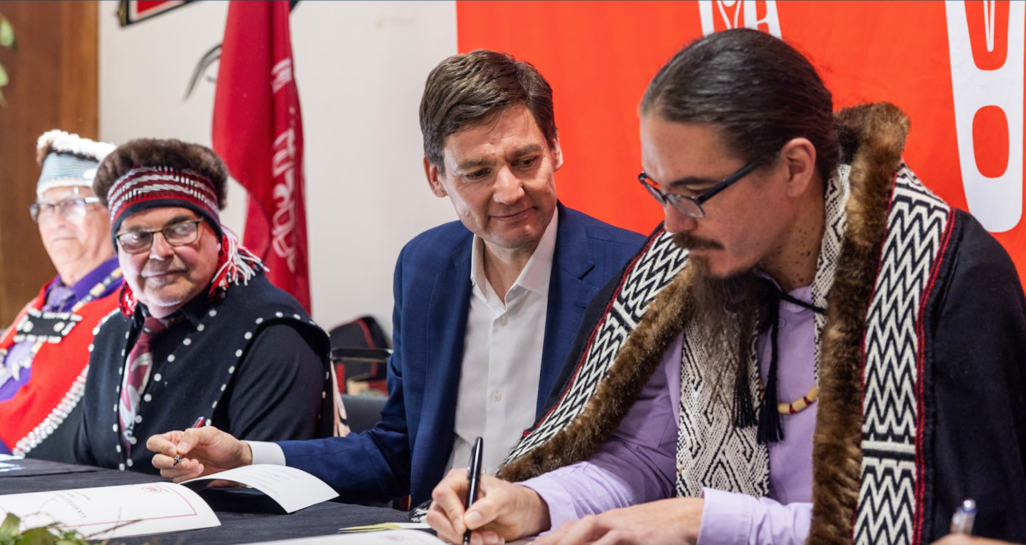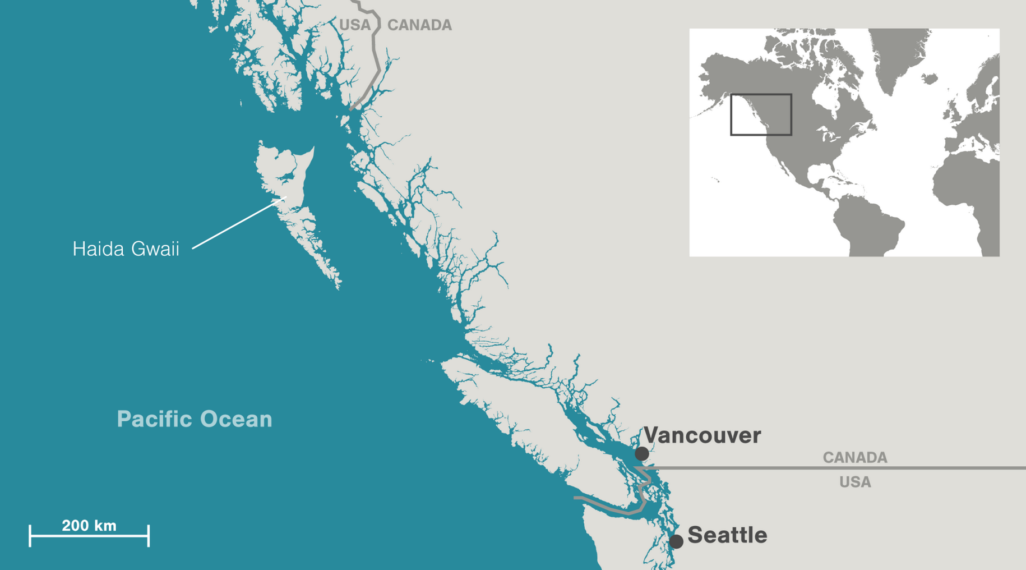
Gaagwiis (Jason Alsop), president of the Council of the Haida Nation, signs the historic Gaayhllxid/Gíihlagalgang “Rising Tide” Haida Title Lands Agreement in April 2024, with British Columbia premier David Eby, center, and Haida vice president Stephen Grosse, second from left, looking on. Photo by Felipe Fittipaldi/Province of British Columbia
By affirming Indigenous land ownership, British Columbia and the Haida Nation are signaling a new era for Indigenous relations.
By Serena Renner
Twenty years ago, Geoff Plant, the then attorney general of British Columbia, made an offer to the Haida Nation. Many West Coast First Nations, including the Haida, had never signed treaties with the Canadian government ceding their traditional lands or resources, and Plant was trying to revive the faltering process of treaty making. He wanted to smooth over relations with Indigenous peoples, but he also wanted to help the province extract more resources from Indigenous lands. To entice the Haida—a nation known throughout Canada for its political savviness and resolve—he had what he thought was a bold bargaining chip.
Like many other officials, Plant viewed the BC government as the clear landlord of provincial lands, including those of the Haida Gwaii archipelago—10,000 square kilometers of forested islands located roughly 650 kilometers northwest of Vancouver, British Columbia, and the Haida’s home for at least the past 13,000 years.

Haida Gwaii features 10,000 square kilometers of forested islands that the Haida Nation has been stewarding for at least 13,000 years. In addition to its 200-plus islands, the nation considers the airspace, seabed, and marine areas of Haida Gwaii part of its Indigenous territory. Map by Mark Garrison
So here was Plant’s pitch: the BC government would give the Haida control of 20 percent of their lands, but that would require the nation dropping a title case it had recently filed with the BC Supreme Court. Title refers to the inherent right to own and manage Indigenous territories based on traditional use and occupation. The Haida maintained that their territory included all of the land area in the archipelago, as well as the surrounding airspace, seabed, and marine waters.
The Haida saw Plant’s offer to the door.
“Why would we give up 80 percent of our land to get 20?” said Gidansda (Guujaaw), the then president of the Council of the Haida Nation, to media at the time. “This case is about respect for the Earth and each other. It is about culture, and it is about life.”
The Haida’s steadfastness paid off. Although Haida leaders have kept a potential court case in their back pocket all these years for leverage, they ultimately haven’t needed it. In April 2024, the Haida Nation and the province of British Columbia announced the Gaayhllxid/Gíihlagalgang “Rising Tide” Haida Title Lands Agreement. In it, the BC government formally recognizes Haida ownership of all the lands of Haida Gwaii. This is the first time in Canadian history that the colonial government has recognized Indigenous title across an entire terrestrial territory, and it’s the first time this kind of recognition has occurred outside of the courts. Experts say it marks a new path toward Indigenous reconciliation.
Read the full article, published April 22, 2024, in Hakai Magazine. This story was republished in six other outlets: The Tyee, The Narwhal, Canada’s National Observer, Yes! Magazine, Inside Climate News, and Resilience.